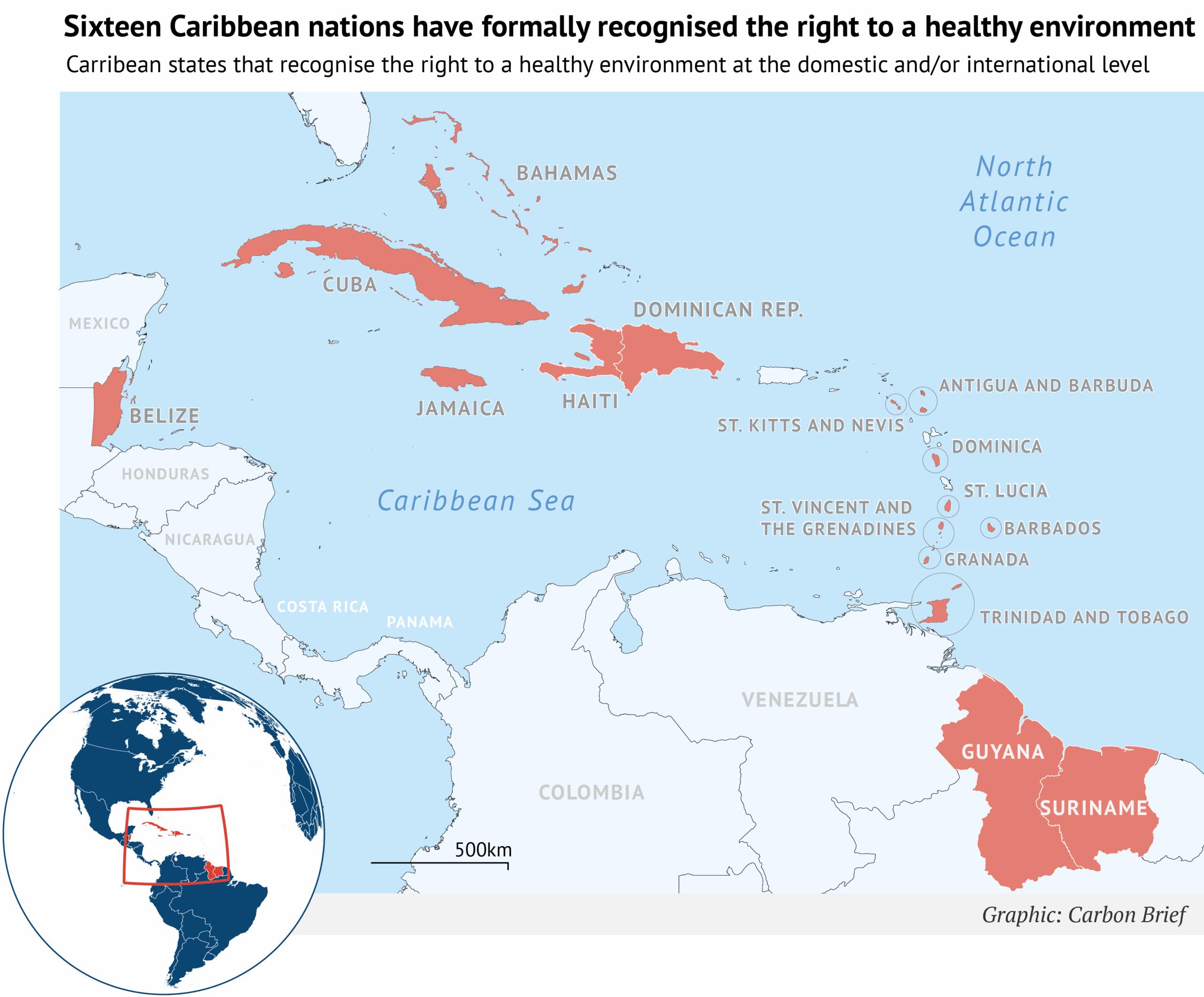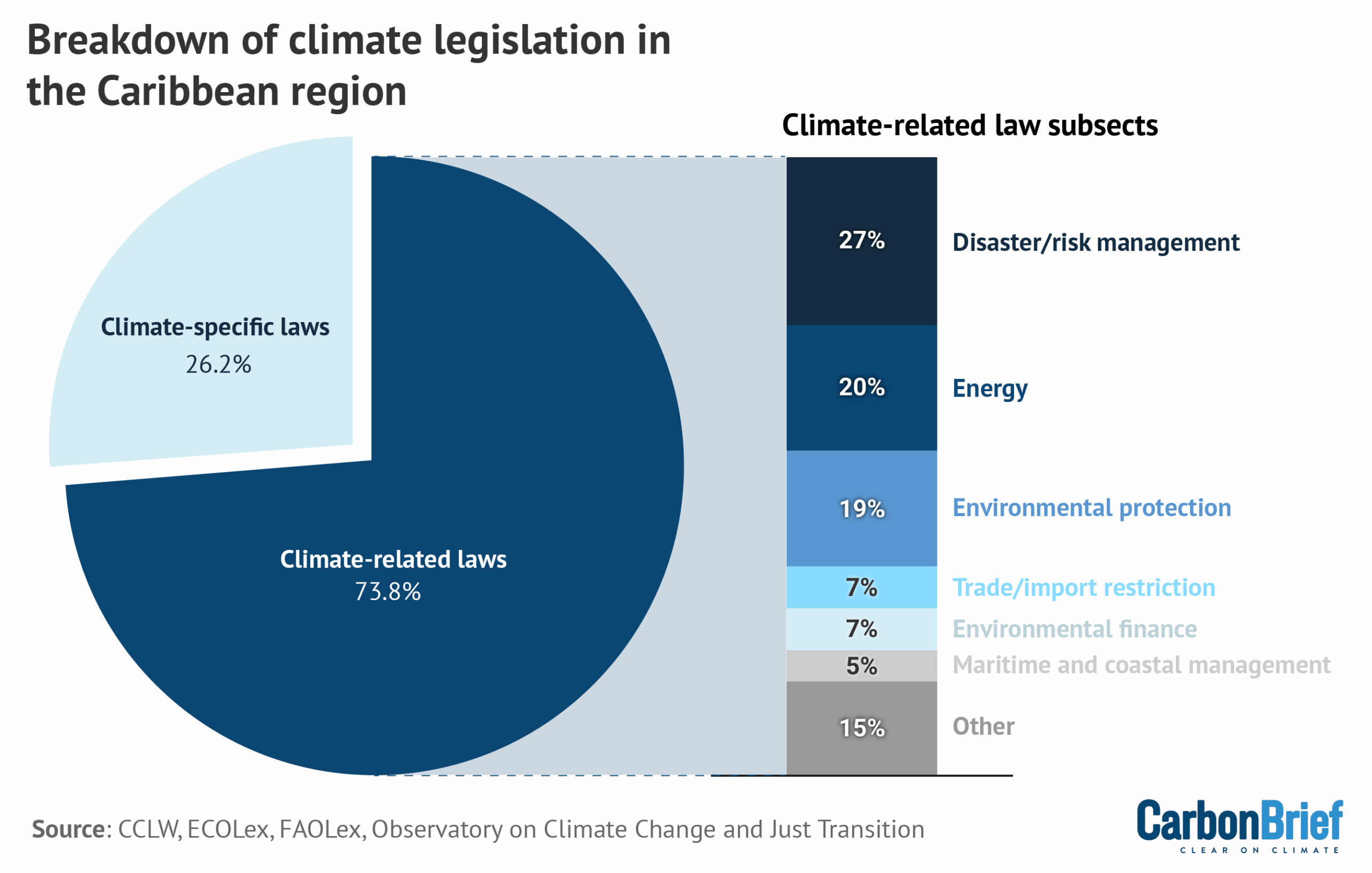Welcome to Carbon Brief’s Cropped.
We handpick and explain the most important stories at the intersection of climate, land, food and nature over the past fortnight.
This is an online version of Carbon Brief’s fortnightly Cropped email newsletter. Subscribe for free here.
Key developments
Mass coral bleaching event
GLOBAL EVENT: The US National Oceanic and Atmospheric Administration (NOAA) announced last week that the “world is currently experiencing a global coral bleaching event” – the fourth ever and the second this decade. “Mass bleaching” of reefs in every major ocean basin has been documented since early 2023, according to NOAA’s Coral Reef Watch. Dr Derek Manzello, the Coral Reef Watch coordinator, said: “When these events are sufficiently severe or prolonged, they can cause coral mortality, which hurts the people who depend on the coral reefs for their livelihoods.” However, death is not a foregone conclusion for bleached reefs – corals can recover if the heat stress diminishes. According to the New York Times, “scientists say it’s too soon to estimate what the extent of global mortality will be”.
-
Sign up to Carbon Brief’s free “Cropped” email newsletter. A fortnightly digest of food, land and nature news and views. Sent to your inbox every other Wednesday.
‘MAKE YOU WEEP’: In order to declare a global bleaching event, the Pacific, Atlantic and Indian Oceans must all have experienced bleaching in the past year and at least 12% of each basin’s reefs must be at temperatures that can cause bleaching, the New York Times reported. It added: “Currently, more than 54% of the world’s coral area has experienced bleaching-level heat stress in the past year.” Prof Terry Hughes, a coral-reef scientist at James Cook University in Australia, tweeted: “The extent AND severity of coral bleaching on the Great Barrier Reef in 2024 is by far the worst ever recorded.” Hughes added that the results of the surveys “would make you weep”. Australia’s ABC News reported that “the devastation couldn’t be more clear”.
BROADER IMPACTS: ABC News noted that the widespread bleaching “is a clear reflection of the extraordinary ocean temperatures in 2023, which have been rising for decades due to the burning of fossil fuels”. The onset of El Niño also “deserve[s] the blame”, according to Prof Matt England, a physical oceanographer from the University of New South Wales, who was quoted in the article. In the Conversation, four researchers from the University of Sydney wrote that “the damage done by heat underwater goes much further” than the reefs alone. They have already noted changes in algae and water chemistry at their research station, while “mobile macroinvertebrates”, such as starfish and sea urchins, “are in widespread decline”. They added: “Much of the damage done this summer [to reef ecosystems] will take months or even years to manifest.”
Oceans in focus
PIVOTAL PROTECTION: The Dominican Republic has become the first Caribbean nation to designate 30% of its marine areas as protected, El País reported – expanding its protected area coverage from 10.8% to 30.8% of its territorial waters. That includes a new protected area that spans the border between the Dominican Republic and Colombia, fulfilling an agreement that the two countries signed in 2022, the Spanish-language newspaper added. This part of the ocean “functions as a pivotal region for species connectivity”, Oceanographic wrote. The magazine added that it is “both a feeding ground and travel route” for seabirds, whales and other diverse marine species.
BOTTOM-TRAWLING BAN: Greece will ban bottom trawling – a destructive form of fishing – in its national marine parks by 2026 and in all of its marine protected areas by 2030, making it “the first country to pledge to this”, Euractiv reported. Greek prime minister Kyriakos Mitsotakis also announced two new marine national parks, increasing the country’s protected waters by 80%. Mitsotakis said: “The ocean has paid a heavy price for its service to humankind. It has been a vital source of life and livelihood. We have not been kind to it in return.” The announcement was made at the “Our Ocean” world conference in Athens.
RATIFICATION RACE: The Our Ocean conference also saw “more than 400 new commitments” of finance for ocean protection, totalling $10bn, according to Reuters. This included 40 commitments from the EU for many activities, “rang[ing] from fighting marine pollution to supporting sustainable fisheries and investments in the so-called blue economy”, the newswire added. At the conference, the EU and 13 other countries’ governments “urged nations…to prioritise the ratification” of the High Seas Treaty, Reuters said. According to the ratification tracker maintained by the High Seas Alliance, the total number of ratifications increased in April to four, with Belize and Seychelles joining early-adopters Palau and Chile. Sixty countries must ratify the agreement before it can take effect.
Spotlight
Latin America and the Caribbean have a new action plan for protecting environmental defenders
In this spotlight, Carbon Brief reports on the main outcomes of the ongoing Conference of the Parties to the Escazú Agreement, established by Latin America and the Caribbean to protect environmental defenders.
The third Conference of the Parties (COP3) to the Escazú Agreement is taking place in Santiago, Chile, from 22 to 24 April.
The Escazú Agreement is a legally binding regional treaty established by Latin American and Caribbean countries in order to protect environmental defenders and promote public participation and access to information on environmental issues. It has the support of the Economic Commission for Latin America and the Caribbean (ECLAC) and came into force on 22 April 2021.
Since then, 15 countries have ratified the agreement, including Argentina, Bolivia, Chile, Mexico and Ecuador, as well as several Caribbean countries, such as Antigua and Barbuda, Grenada and Saint Kitts and Nevis.
Latin America and the Caribbean accounted for 88% of the world’s environmental and land defenders killings over the previous decade, according to a 2023 report from campaign group Global Witness. The region saw 1,910 killings of defenders between 2012 and 2022, the report noted.
On Tuesday, COP3 saw the approval of the regional action plan on human rights defenders in environmental matters. The document sets out priority areas and strategies to enact article 9 of the Escazú Agreement, which establishes that each party should take action to recognise and protect the rights of environmental defenders and prevent and punish attacks against them.
Graciela Martínez, regional campaigner for the Americas at Amnesty International, told Carbon Brief that the action plan “may be an important step towards the implementation of the Escazú Agreement”. She added that the plan “provides more specific routes for the parties to meet” the agreement – for example, establishing cooperation between parties and recognition of defenders.
Teresita Antazú López, an Indigenous environmental defender of the Yanesha people of the central Peruvian rainforest, told Carbon Brief that Indigenous peoples have a number of demands at this COP. According to López, who was attending the COP as a member of the Interethnic Association for the Development of the Peruvian Jungle, the highest priority is to ensure their effective participation within the negotiations going forward. This includes having an Indigenous caucus to represent them and an Indigenous peoples rapporteur to report on violations in their territories.
As well as public participation and the protection of environmental and land defenders, COP3 has also addressed transparency and access to environmental information.
During a side event hosted by Article 19 Mexico and Central America – an organisation that promotes freedom of expression and access to information – Lourdes Medina, a lawyer specialising in environmental and Indigenous rights, said that if the right to access environmental information is not protected and guaranteed, then other rights are at risk. Medina said:
“The participation of citizens in resistance cannot be guaranteed. There is no adequate mechanism for access to justice and this produces danger and different forms of violence against defenders of human rights in environmental matters.”
News and views
FEELING THE HEAT: Florida governor Ron DeSantis signed a bill preventing local governments in the state from requiring heat-exposure protections for outdoor workers, the Tampa Bay Times reported. The bill was introduced in response to a proposal in Miami-Dade county that would have required employers to provide water and shade breaks to agricultural and construction workers when the heat index is above 95F (35C). More than 90 organisations signed an open letter to the governor saying that removing “local governments’ ability to protect workers from climate-caused extreme heat is inhumane”, according to the newspaper. USA Today wrote that the new law has “frustrated and angered some experts and advocates for construction workers and farmworkers”. It added that “extreme heat kills more people in the US each year than all forms of extreme weather combined”.
ATTRIBUTION IN AFRICA: BBC News covered two new rapid attribution studies from the World Weather Attribution group that focused on Africa. The first found that the ongoing drought in southern Africa that has resulted in crop failures, disease outbreaks and emergency declarations in several countries was influenced by El Niño and not climate change. The second study found that last month’s “deadly heatwave” in west Africa and the Sahel region would have been “impossible” in the absence of human-driven climate change. Meanwhile, “erratic” rain and rising temperatures are putting winegrowers in South Africa’s Western Cape province at risk, according to Agence-France Presse. One winemaker told the website: “If people don’t believe in global warming, they should come to South Africa.”
FOOD CONTROVERSY: Academics from Leiden University and New York University sent a letter to the UN Food and Agriculture Organization (FAO) “urgently requesting a retraction” of its report on pathways towards lower emissions from livestock, which cites their work. They said the report “seriously distorts” their findings regarding the greenhouse gas mitigation potential of dietary changes and pointed out errors in framing, methodology and data. According to the Guardian, although FAO reports are consulted by international bodies, the organisation “is also mandated to increase livestock productivity so as to bolster nutrition and food security”. A FAO spokesperson told the outlet the institution “will look into the issues raised by the academics and undertake a technical exchange of views with them”.
RE-PEAT: A bill introduced in the UK’s House of Commons last week was the government’s “last chance” to fulfil its promise to ban the sale of peat for gardening uses by the end of the current Parliament, according to the Wildlife Trusts. The legislation was introduced by former environment secretary Theresa Villiers, who noted that “peatlands are the UK’s largest carbon store”, according to the ENDS Report. One conservative politician “asked that it be put on the record that the bill ‘will not go unopposed’”, the outlet added. In the Yorkshire Post, Villiers noted that 95% of respondents to the government’s consultation in 2021 supported such a ban. The bill will be presented in the House of Commons again on Friday, 26 April.
‘SOUND’ EVIDENCE: Energy Monitor covered a recent Nature study revealing that forest-based solutions, including forest carbon credits, are supported by more “sound” scientific evidence than other types of nature-based solutions. The outlet noted that forest carbon credits have come under scrutiny for their accounting methods and their impacts on forest communities. The study examined the mitigation potential of 43 nature-based solutions and found that four of them – all related to the conservation and restoration of tropical and temperate forests – “offer the greatest certainty in carbon mitigation potential”.
‘BETTER’ MEAT: The World Resources Institute thinktank published a new report aimed at helping food companies achieve climate, sustainability and ethical goals by sourcing “better” meat – where “better” refers to “environmental, social, ethical and/or economic attributes”. The report recommended six steps companies can take, including calculating the emissions baselines of their food purchases, assessing the potential environmental impacts of their new strategies and engaging with suppliers. The report noted that “better” meat is often associated with higher environmental impacts alongside possible improvements in animal welfare. It also laid out strategies to reduce greenhouse gas emissions from meat production.
Watch, read, listen
WILDLIFE CROSSINGS: A feature in CBS news explored how wildlife crossings throughout the US are reducing roadkill and helping preserve the genetic diversity of species.
GULLIES EXPANSION: BBC News explained how soil degradation has swallowed entire neighbourhoods in Latin America and Africa.
PROTECTING THE AMAZON: A documentary by Al Jazeera showed how the Indigenous Yanomami tribe fight to protect Brazil’s Amazon rainforest from illegal gold mining.
HIMALAYAN DISPUTE: A CNN World multimedia article addressed how herders in a northern Indian community are losing their lands to climate change and border tensions with China.
New science
Frugivores enhance potential carbon recovery in fragmented landscapes
Nature Climate Change
New research found that fruit-eating animals – “frugivores” – play an important role in dispersing the seeds of carbon-dense trees, but this is being put at risk by forest fragmentation. Using ground-based data gathered in the Atlantic forest of Brazil, scientists showed that large fruit-eating birds are responsible for dispersing the seeds of trees with the highest carbon-storing potential, but that the animals are restricted from doing this when tree cover falls below 40%. The restricted movement of large fruit-eating birds has the potential to reduce forest “biomass” – the total weight of plants in a given area – by up to 38%, the researchers estimated. They concluded: “Active restoration (for example, planting trees) is required in more fragmented landscapes to achieve carbon and biodiversity targets.”
Impacts of fire and prospects for recovery in a tropical peat forest ecosystem
Proceedings of the National Academy of Sciences
Fires in tropical peatland forests lead to the proliferation of non-forest vegetation and the erosion of biodiversity – although some affected forests may show “some signs of recovery” after a 12-year period, according to a new study. The researchers tracked ecosystem properties and biodiversity variables in a tropical peatland in Indonesia over 16 years. The analysis showed that most ecosystems and biodiversity are “sensitive to recurrent high-intensity fire”. The paper concluded: “If left uncontrolled, fire may be a pervasive threat to the ecological functioning of tropical forests, underscoring the importance of fire prevention and long-term restoration efforts.”
Emergency policies are not enough to resolve Amazonia’s fire crises
Communications Earth & Environment
Emergency “fire bans” in Brazil – such as those implemented in 2019 – have been “largely ineffective” and must be combined with longer-term strategies to reduce the risks of fire, new research said. Scientists compared the number of observed “fire counts” in the Brazilian Amazon over 2019-21 to the number of expected fires based on climatic conditions. They found that while the 2019 ban did significantly reduce the number of fires, the same intervention was “much less effective” in 2020 and 2021. The authors argued that solving the “fire crisis” will require “target[ing] the underlying causes of fire”, engaging with local communities and building long-term management strategies and education campaigns.
In the diary
- 24 April: Webinar: Gender dimensions of post-harvest losses: Insights from a systematic review | Alliance of Bioversity International and CIAT and CGIAR GENDER Impact Platform
- 3 May: World Press Freedom Day
- 6-10 May: 19th session of the UN Forum on Forests | New York City
- 11 May: World Migratory Bird Day
Cropped is researched and written by Dr Giuliana Viglione, Aruna Chandrasekhar, Daisy Dunne, Orla Dwyer and Yanine Quiroz. Please send tips and feedback to cropped@carbonbrief.org
The post Cropped 24 April 2024: Mass coral bleaching; FAO report retraction request; Escazú Agreement appeared first on Carbon Brief.
Cropped 24 April 2024: Mass coral bleaching; FAO report retraction request; Escazú Agreement
Greenhouse Gases
DeBriefed 10 October 2025: Renewables power past coal; Legacy of UK’s Climate Change Act; Fukushima’s solar future
Welcome to Carbon Brief’s DeBriefed.
An essential guide to the week’s key developments relating to climate change.
This week
Renewables overtake coal
‘HISTORIC FIRST’: Renewables have overtaken coal to become the world’s leading source of electricity for the first six months of this year in a “historic first”, BBC News said. The analysis, from the thinktank Ember, found the world generated “almost a third” more solar power in the first half of the year, compared with the same period in 2024, while wind power grew by “just over 7%,” reported the Guardian.
HEAVY LIFTING: According to the report, China and India were “largely responsible for the surge in renewables”, while the US and Europe “relied more heavily on fossil fuels,” the Guardian wrote. China built more renewables than every other country combined in the first half of this year, the newspaper added.
CONTINENTAL SHIFTS: A second report from the International Energy Agency (IEA) predicted a “surge” in global wind and solar capacity by 2030, but shaved 5% off its previous forecast, the Financial Times said. The IEA revealed that India is set to become the second-largest growth market for renewables after China, “with capacity expected to increase 2.5 times by 2030”, Down to Earth reported. The IEA also upped its forecast for renewables in the Middle East and north Africa by 23%, “helped by Saudi Arabia rolling out wind turbines and solar panels”, but halved the outlook for the US, the FT noted.
Around the world
- EV BOOM: Sales of electric and hybrid cars made up “more than half” of all new car registrations in the UK last month, a new record, according to data from the Society of Motor Manufacturers, reported BBC News.
- BANKING COLLAPSE: A global banking alliance launched by the UN to get banks to slash the carbon footprint of their loans and investments and help drive the transition to a net-zero economy by 2050 has collapsed after four years, Agence France-Press reported.
- CUTS, CUTS, CUTS: The Trump administration plans to cut nearly $24bn in funding for more than 600 climate projects across the US, according to documents reviewed by the Wall Street Journal.
- PEOPLE POWER: A farmer, a prison guard and a teacher were among those from the Dutch-Caribbean island Bonaire who appeared at the Hague on Tuesday to “accuse the Netherlands of not doing enough to protect them from the effects of climate change”, Politico reported.
400,000
The number of annual service days logged by the US National Guard responding to hurricanes, wildfires and other natural disasters over the past decade, according to a Pentagon report to Congress, Inside Climate News reported.
Latest climate research
- Politicians in the UK “overwhelmingly overestimate the time period humanity has left to bend the temperature curve”, according to a survey of 100 MPs | Nature Communications Earth and Environment
- Fire-driven degradation of the Amazon last year released nearly 800m tonnes of CO2 equivalent, surpassing emissions from deforestation and marking the “worst Amazon forest disturbance in over two decades” | Biogeosciences
- Some 43% of the 200 most damaging wildfires recorded over 1980-2023 occurred in the last decade | Science
(For more, see Carbon Brief’s in-depth daily summaries of the top climate news stories on Monday, Tuesday, Wednesday, Thursday and Friday.)
Captured

The UK’s Climate Change Act, landmark legislation that guides the nation’s response to climate change, is increasingly coming under attack from anti-net-zero right-leaning politicians. In a factcheck published this week, Carbon Brief explained how the UK’s Climate Change Act was among the first comprehensive national climate laws in the world and the first to include legally binding emissions targets. In total, 69 countries have now passed “framework” climate laws similar to the UK’s Climate Change Act, with laws in New Zealand, Canada and Nigeria among those explicitly based on the UK model. This is up from just four when the act was legislated in 2008. Of these, 14 are explicitly titled the “Climate Change Act”.
Spotlight
Fukushima’s solar future
This week, Carbon Brief examines how Fukushima helped to recover from nuclear disaster by building solar farms on contaminated farmland.
On 11 March 2011, an earthquake off the pacific coast of Japan caused 15m-tall waves to crash into the eastern region of Tōhoku, killing 19,500 people and injuring a further 6,000.
In the aftermath, flooding at the Fukushima Daichi nuclear power plant caused cooling systems to fail, leaching radioactive contaminants into the soil and leading to a major nuclear incident.
Some 1,200km2 around the site was restricted and up to 100,000 people were evacuated – in some cases forever.
In the years following, Japan entered a fraught debate about nuclear energy.
In 2010, nuclear power provided 25% of Japan’s electricity, but, in the years following the disaster, its 54 nuclear reactors were taken offline.
Successive governments have fought over reintroducing nuclear power. Today, some 14 reactors are back online, 27 have been permanently closed and another 19 remain suspended. (Japan’s newly-elected prime minister Sanae Takaichi has promised to make nuclear central to her energy strategy.)
Against this backdrop, Fukushima – a prefecture home to 1.8 million people – has emerged as a surprise leader in the renewables race.
In 2014, the Fukushima Renewable Energy Institute (FREA) opened with the twin goals of promoting research and development into renewable energy, while “making a contribution to industrial clusters and reconstruction”.
That same year, the prefecture declared a target of 100% renewable power by 2040.
Contaminated land
“A lot of these communities, I know, were looking for ways to revitalise their economy,” said Dr Jennifer Sklarew, assistant professor of energy and sustainability at George Mason University and author of “Building Resilient Energy Systems: Lessons from Japan”.
Once evacuation orders were lifted, however, residents in many parts of Fukushima were faced with a dilemma, explained Skarlew:
“Since that area was largely agricultural, and the agriculture was facing challenges due to stigma, and also due to the soil being removed [as part of the decontamination efforts], they had to find something else.”
One solution came in the form of rent, paid to farmers by companies, to use their land as solar farms.
Michiyo Miyamoto, energy finance specialist at the Institute for Energy Economics and Financial Analysis, told Carbon Brief:
“The [Fukushima] prefecture mapped suitable sites early and conducted systematic consultations with residents and agricultural groups before projects were proposed. This upfront process reduced land-use conflicts, shortened permitting timelines and gave developers clarity.”
As a result, large-scale solar capacity in Fukushima increased to more than 1,300 megawatts (MW) from 2012 to 2023, according to Miyamoto. Moreover, installed renewable capacity now exceeds local demand, meaning the region can run entirely on clean power when conditions are favourable, Miyamoto said.
Today, aerial pictures of Fukushima reveal how solar panels have proliferated on farmland that was contaminated in the nuclear disaster.

Charging on
Last year, 60% of Fukushima’s electricity was met by renewables, up from 22% in 2011. (The country as a whole still lags behind at 27%.)
And that is set to grow after Japan’s largest onshore windfarm started operations earlier this year in Abukuma, Fukushima, with a capacity of 147MW.
The growth of solar and wind means that Fukushima is already “ahead of schedule” for its 2040 target of 100% renewable power, said Miyamoto:
“The result is a credible pathway from recovery to leadership, with policy, infrastructure and targets working in concert.”
Watch, read, listen
OVERSHOOT: The Strategic Climate Risks Initiative, in partnership with Planet B Productions, has released a four-part podcast series exploring what will happen if global warming exceeds 1.5C.
DRONE WARFARE: On Substack, veteran climate campaigner and author Bill McKibben considered the resilience of solar power amid modern warfare.
CLIMATE AND EMPIRE: For Black history month, the Energy Revolution podcast looked at how “race and the legacies of empire continue to impact the energy transition”.
Coming up
- 12 October: presidential elections, Cameroon
- 13-14 October: Pre-COP, Brasilia, Brazil
- 13-18 October: World Bank Group/IMF annual meetings, Washington DC
- 14-17 October: 2nd extraordinary session of the Marine Environment Protection Committee at the International Maritime Organisation, London
- 15-16 October: Circle of Finance Ministers report
Pick of the jobs
- Buckinghamshire Council, principal climate change officer | Salary: £49,354-£51,759. Location: Aylesbury, Buckinghamshire
- Sustainable NI, sustainable business lead | Salary: £60,000. Location: Belfast, Northern Ireland
- Dialogue Earth, South Asia managing editor | Salary: £1,875 per month. Location: South Asia
DeBriefed is edited by Daisy Dunne. Please send any tips or feedback to debriefed@carbonbrief.org.
This is an online version of Carbon Brief’s weekly DeBriefed email newsletter. Subscribe for free here.
The post DeBriefed 10 October 2025: Renewables power past coal; Legacy of UK’s Climate Change Act; Fukushima’s solar future appeared first on Carbon Brief.
Greenhouse Gases
Guest post: How Caribbean states are shifting climate legislation
The Caribbean region is among the most vulnerable to climate change, despite historically contributing less than half of one percent of global greenhouse gas emissions.
Rising sea levels, extreme heat and more frequent and intense storms – such as the 2024 Hurricane Beryl, which made landfall in Grenada – pose urgent and growing threats to the small island states, coastal nations and overseas territories that comprise the Caribbean region.
With global progress to address climate change still too slow, Caribbean countries are taking matters into their own hands by enacting more robust legislation to help protect against climate risks.
In a new study published in the Carbon and Climate Law Review, we identified 78 climate laws and legally binding decrees across 16 Caribbean states, as well as two constitutional references to climate change and a growing recognition of the right to a healthy environment.
Our analysis suggests that, together, these developments are not only enhancing resilience, but also positioning Caribbean states as influential actors in the global climate arena.
Caribbean climate laws on the rise
Climate governance in the Caribbean has expanded significantly in recent years. In the past decade, countries such as Cuba and the Dominican Republic have embedded climate obligations and programmatic guidelines into their national constitutions.
At the same time, legislative recognition of the human right to a healthy environment is gaining momentum across the region. Six Caribbean nations now affirm the right in their constitutions, while 15 have recognised it through international instruments, such as the UN Council, UN Assembly and the Escazu Agreement, as shown in the figure below.

More recently, there has been a notable rise in targeted, sector-specific climate frameworks that go beyond broader environmental statutes.
Saint Lucia stands out as the only country with a climate framework law, or a comprehensive national law that outlines long-term climate strategies across multiple domains. Meanwhile, several other Caribbean governments have adopted climate-specific laws that focus on individual sectors, such as energy, migration and disaster management.
According to our analysis, more than a quarter of climate-relevant legislation in the region – comprising 21 laws and legally binding decrees – now has an explicit focus on climate change, as illustrated in the chart below.
Our research suggests that this represents an ongoing shift in legislative focus, reflecting changes in how climate legislation is being structured in one of the world’s most climate-vulnerable regions.

Caribbean nations are also advancing legal reforms to structure and institutionalise climate finance and market mechanisms directly into domestic law, aligned with Article 6.2 of the Paris Agreement.
For example, the Bahamas has introduced provisions for carbon credit trading, while Antigua and Barbuda, Barbados and Grenada have established national climate financing mechanisms to support mitigation and adaptation efforts.
Some states, including Belize and Saint Kitts and Nevis, have incorporated regional bodies such as the Caribbean Community Climate Change Centre – the climate arm of the intergovernmental Caribbean community organisation CARICOM – into national frameworks. This indicates an increasing alignment between regional cooperation and domestic law.
In addition to the influx of regulations specifically addressing climate change, Caribbean nations are also legislating broader environmental issues, which, in turn, could provide increased resilience from climate impacts and risks, as shown in the graph above.
Key trends in these types of climate-related laws include the expansion of disaster risk management governance, which addresses national preparedness for climate-induced weather events or related catastrophes. Likewise, energy law is an increasingly prominent focus, with countries including Antigua and Barbuda and Saint Vincent and the Grenadines integrating renewable energy and energy efficiency goals into national climate governance.
More broadly, many Caribbean nations have adopted wide-ranging and comprehensive environmental laws, many of which were developed in alignment with existing climate commitments. In combination, these legal developments reflect a dynamic and evolving climate governance landscape across the region.
Proactive vs reactive approaches
Despite general alignment with these broader regional trends, our research reveals distinct developmental pathways shaping domestic climate regulation.
In the eastern Caribbean, for example, we saw both proactive, long-term planning strategies and reactive, post-disaster reforms.
Saint Lucia’s multifaceted approach to climate resilience evolved steadily over the course of more than a decade. During this time, the country developed numerous adaptation plans, strengthened cross-sectoral coordination and engaged in institutional climate reforms in areas such as energy, tourism, finance and development.
More recently, the passage of Saint Lucia’s Climate Change Act in 2024 marked a milestone in climate governance, by giving legal force to the country’s obligations under the UNFCCC, the Kyoto Protocol and the Paris Agreement – making Saint Lucia one of the few small island states to incorporate global climate commitments into domestic law.
Our research indicates that this strategy has not only positioned the country as a more climate-resilient nation, but also solidified its access to international climate financing.
In contrast, Dominica’s efforts evolved more rapidly in the aftermath of Hurricane Maria in 2017, which destroyed over 200% of the country’s GDP. The storm’s impacts were felt across the country and hit particularly hard for the Kalinago people – the Caribbean’s last Indigenous community – highlighting the role of socioeconomic disparities in shaping climate vulnerability and resilience.
In response, the government passed the Climate Resilience Act, creating the temporary Climate Resilience Execution Agency for Dominica (CREAD).
Beyond establishing an exclusively climate-focused institution, the act aimed to embed resilience into governance by mandating the participation of vulnerable communities – including Indigenous peoples, women, older people and people with disabilities – in shaping and monitoring climate resilience projects.

As noted in a recent statement by the UN special rapporteur on Climate Change, Dr Elisa Morgera, these frameworks underscore the government’s ambition to become the world’s first “climate-resilient nation.”
Although challenges persist, Dominica’s efforts demonstrate how post-disaster urgency can drive institutional change, including the integration of rights and resilience into climate governance.
Uneven progress and structural gaps
Despite significant progress, our research shows that several key opportunities for climate governance across the Caribbean continue to exist, which could enable improvements in both resilience and long-term ambition.
The region’s legal landscape remains somewhat heterogeneous. While Saint Lucia has enacted a comprehensive climate framework law, the rest of the region lacks similar blanket legislation. This includes some states that entirely lack climate-specific laws, instead relying on related laws and frameworks to regulate and respond to climate-related risks.
Other nations have yet to adopt explicit disaster-risk management frameworks, leaving Caribbean populations vulnerable before, during and after climate emergencies. Most have yet to enshrine the right to a healthy environment at the national level.
Our research suggests that outdated legal frameworks are further limiting progress in addressing current climate risks. Because many of the longer-standing environmental laws in the region were adopted well before climate policy became a mainstream concern, some fail to address the nature, frequency and intensity of modern climate challenges, such as sea-level rise, tropical storms, wildfires, floods, droughts and other impacts.
More broadly, many Caribbean climate laws include limited integration of gender equity, Indigenous rights and social justice. As Caribbean nations such as Grenada and the Dominican Republic begin to link climate resilience with these issues, the region has an opportunity to lead by example.
Ultimately, capacity and resource constraints persist as significant barriers to implementation and adaptation.
The Caribbean region faces debt that exacerbates ongoing development challenges, a burden made heavier by the repeated economic shocks of climate-related disasters. Along with regional debt-for-resilience schemes, increased funding from high-emitting countries to support adaptation measures in climate-vulnerable nations – as endorsed under the Paris Agreement – is likely to be critical to ensuring the region’s climate laws can be executed effectively.
Global implications of Caribbean climate law
Our research suggests that Caribbean countries are outpacing other regions in terms of the scope and ambition of their climate laws. This legislation has the potential to serve as a model for climate-vulnerable nations worldwide.
Continuing efforts in the region show that legal frameworks in the field can not only drive resilience, embed rights and strengthen claims to international finance, but also highlight how regional cooperation and diplomacy can enhance global influence.
These findings demonstrate that innovation in climate law need not wait for action from major emitters, but can instead be led by those on the front lines of climate change.
The post Guest post: How Caribbean states are shifting climate legislation appeared first on Carbon Brief.
Guest post: How Caribbean states are shifting climate legislation
Greenhouse Gases
IEA: Renewables have cut fossil-fuel imports for more than 100 countries
More than 100 countries have cut their dependence on fossil-fuel imports and saved hundreds of billions of dollars by continuing to invest in renewables, according to the International Energy Agency (IEA).
It says nations such as the UK, Germany and Chile have reduced their need for imported coal and gas by around a third since 2010, mainly by building wind and solar power.
Denmark has cut its reliance on fossil-fuel imports by nearly half over the same period.
Renewable expansion allowed these nations to collectively avoid importing 700m tonnes of coal and 400bn cubic metres of gas in 2023, equivalent to around 10% of global consumption.
In doing so, the fuel-importing countries saved more than $1.3tn between 2010 and 2023 that would otherwise have been spent on fossil fuels from overseas.
Reduced reliance
The IEA’s Renewables 2025 report quantifies the benefits of renewable-energy deployment for electricity systems in fossil fuel-importing nations.
It compares recent trends in renewable expansion to an alternative “low renewable-energy source” scenario, in which this growth did not take place.
In this counterfactual, fuel-importing countries stopped building wind, solar and other non-hydropower renewable-energy projects after 2010.
In reality, the world added around 2,500 gigawatts (GW) of such projects between 2010 and 2023, according to the IEA, more than the combined electricity generating capacity of the EU and US in 2023, from all sources. Roughly 80% of this new renewable capacity was built in nations that rely on coal and gas imports to generate electricity.
The chart below shows how 31 of these countries have substantially cut their dependence on imported fossil fuels over the 13-year period, as a result of expanding their wind, solar and other renewable energy supplies. All of these countries are net importers of coal and gas.

In total, the IEA identified 107 countries that had reduced their dependence on fossil fuel imports for electricity generation, to some extent due to the deployment of renewables other than hydropower.
Of these, 38 had cut their reliance on electricity from imported coal and gas by more than 10 percentage points and eight had seen that share drop by more than 30 percentage points.
Security and resilience
The IEA stresses that renewables “inherently strengthen energy supply security”, because they generate electricity domestically, while also “improving…economic resilience” in fossil-fuel importer countries.
This is particularly true for countries with low or dwindling domestic energy resources.
The agency cites the energy crisis exacerbated by Russia’s invasion of Ukraine, which exposed EU importers to spiralling fossil-fuel prices.
Bulgaria, Romania and Finland – which have historically depended on Russian gas for electricity generation – have all brought their import reliance close to zero in recent years by building renewables.
In the UK, where there has been mounting opposition to renewables from right-wing political parties, the IEA says reliance on electricity generated with imported fossil fuels has dropped from 45% to under 25% in a decade, thanks primarily to the growth of wind and solar power.
Without these technologies, the UK would now be needing to import fossil fuels to supply nearly 60% of its electricity, the IEA says.
Other major economies, notably China and the EU, would also have had to rely on a growing share of coal and gas from overseas, if they had not expanded renewables.
As well as increasing the need for fossil-fuel imports from other countries, switching renewables for fossil fuels would require significantly higher energy usage “due to [fossil fuels’] lower conversion efficiencies”, the IEA notes. Each gigawatt-hour (GWh) of renewable power produced has avoided the need for 2-3GWh of fossil fuels, it explains.
Finally, the IEA points out that spending on renewables rather than imported fossil fuels keeps more investment in domestic economies and supports local jobs.
The post IEA: Renewables have cut fossil-fuel imports for more than 100 countries appeared first on Carbon Brief.
IEA: Renewables have cut fossil-fuel imports for more than 100 countries
-
Climate Change2 years ago
Spanish-language misinformation on renewable energy spreads online, report shows
-
Climate Change2 months ago
Guest post: Why China is still building new coal – and when it might stop
-
Climate Change Videos2 years ago
The toxic gas flares fuelling Nigeria’s climate change – BBC News
-

 Greenhouse Gases1 year ago
Greenhouse Gases1 year ago嘉宾来稿:满足中国增长的用电需求 光伏加储能“比新建煤电更实惠”
-
Greenhouse Gases2 months ago
Guest post: Why China is still building new coal – and when it might stop
-

 Climate Change1 year ago
Climate Change1 year ago嘉宾来稿:满足中国增长的用电需求 光伏加储能“比新建煤电更实惠”
-

 Carbon Footprint2 years ago
Carbon Footprint2 years agoUS SEC’s Climate Disclosure Rules Spur Renewed Interest in Carbon Credits
-
Renewable Energy3 months ago
US Grid Strain, Possible Allete Sale













